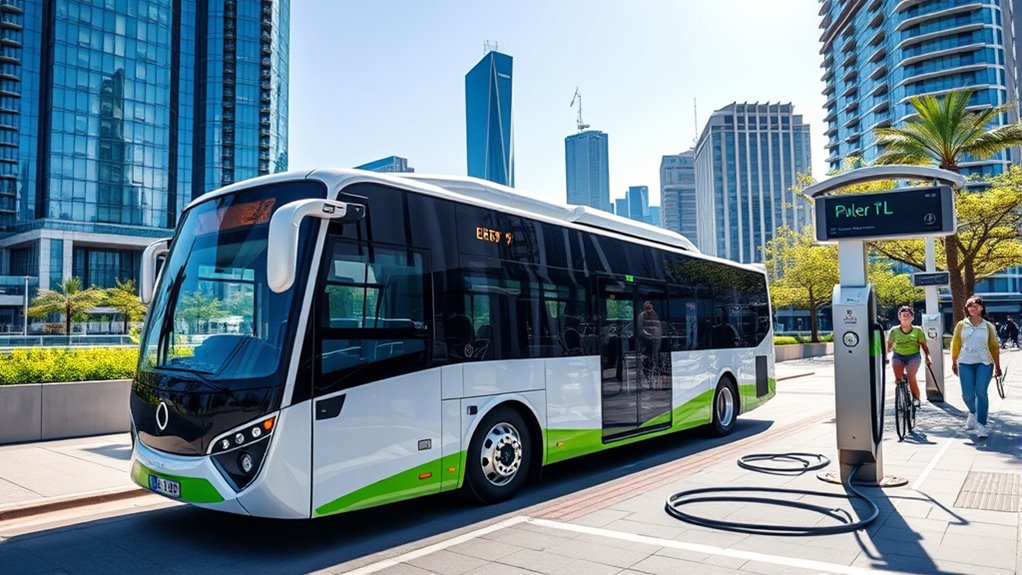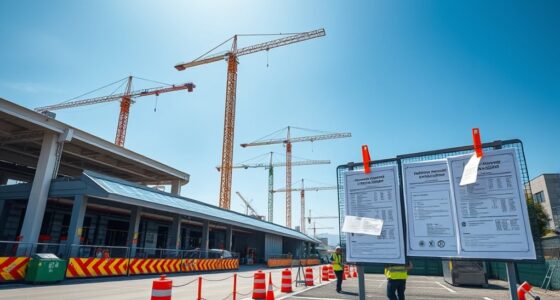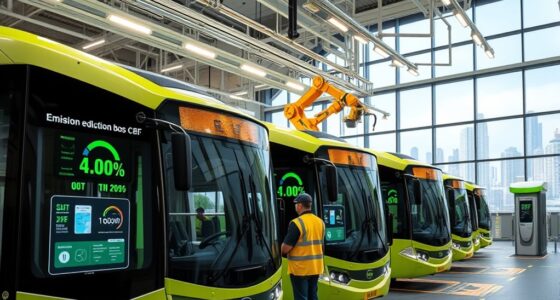The EU has recently strengthened its regulations to boost electric bus adoption, aiming for substantial emissions reductions by 2030 and beyond. These rules promote industry support through incentives, standardized charging infrastructure, and stricter emissions standards for new vehicles. Nearly half of new city buses sold in 2024 are electric, reflecting the policy impact. If you want to explore how these measures shape industry growth and infrastructure, there’s more to uncover ahead.
Key Takeaways
- EU mandates a 45% emission reduction for new heavy-duty vehicles by 2030, increasing to 65% in 2035 and 90% by 2040.
- Regulations support electric bus adoption through standards ensuring interoperability and incentives for manufacturers and cities.
- Nearly 50% of new city buses sold in the EU in 2024 are electric, reflecting regulatory-driven market growth.
- Policies like the European Green Deal and Clean Bus Deployment Initiative promote electric vehicle deployment and infrastructure development.
- Industry regulations include reducing production costs, enhancing battery technology, and providing incentives to accelerate electric bus adoption.

Are you wondering how the EU is shaping the future of urban transportation? The European Union has established ambitious emissions reduction targets for heavy-duty vehicles, including buses, with a clear focus on electrification. By 2030, new heavy-duty vehicles must cut emissions by 45%, progressing to 65% by 2035, and reaching a 90% reduction by 2040. City buses now have a separate category, emphasizing sales targets rather than strict emission reductions, which encourages manufacturers to innovate and produce more electric models. The overarching goal is to transition towards zero-emission vehicles, with electric buses playing a central role in this shift.
This regulatory framework actively supports manufacturers and cities to adopt cleaner, more sustainable transportation options, aligning with the EU’s broader strategy to combat climate change. Additionally, regulatory consistency helps streamline industry efforts and reduce uncertainty for manufacturers and municipalities alike. The development of electric vehicle standards further facilitates industry-wide adoption and interoperability of electric bus systems, ensuring smoother integration into existing urban transit networks.
The rapid adoption of zero-emission buses in EU cities highlights the effectiveness of these policies. In 2024, nearly half of all new city buses sold across the EU are electric, showcasing a significant trend toward greener urban transit. Cities are increasingly demanding electric buses to improve air quality and meet environmental commitments, which drives market growth despite existing production challenges.
Producing electric buses in Europe remains costly, with prices 30-40% higher than traditional diesel models, and supply chain risks continue to pose obstacles. The industry is also exploring innovative manufacturing techniques to reduce costs and improve scalability. Nevertheless, projections suggest that electric bus manufacturing will soon meet the rising demand as technology advances and economies of scale kick in.
EU policies such as the European Green Deal and the Clean Bus Deployment Initiative bolster this momentum. These initiatives promote the deployment of electric and zero-emission vehicles, supported by regulatory measures that incentivize manufacturers and cities alike. Reduced fines for non-compliance and potential incentives further motivate industry players to accelerate their transition.
Detailed policy repositories provide transparency and guidance, ensuring stakeholders stay informed about ongoing regulatory changes.
Economic considerations are central to the ongoing shift. Higher production costs and supply risks challenge market expansion, but economic incentives and investments in charging infrastructure help offset these hurdles. Over time, electric buses offer lower operational costs, which can improve their economic viability and encourage wider adoption.
Technological advancements, especially in battery technology, are continually improving the efficiency and range of electric buses, making them more practical for urban transit needs. As these innovations progress and infrastructure expands, electric buses are poised to become a standard feature in European cities, driven by the EU’s exhaustive regulatory approach that fosters a cleaner, more sustainable transportation future. Furthermore, market demand continues to push manufacturers to innovate and adapt to evolving regulatory requirements.
Frequently Asked Questions
How Will These Regulations Impact Electric Bus Manufacturing Costs?
You’ll see manufacturing costs for electric buses change as demand grows. Increased production can lead to economies of scale, lowering component and assembly costs.
You might also invest more in R&D and advanced technologies, which can initially raise expenses but improve efficiency long-term.
While compliance costs could spike initially, the overall trend toward larger markets and innovation will likely reduce costs over time, making electric buses more affordable.
Are There Specific Incentives for Small Bus Operators Under New Rules?
You might wonder if small bus operators get specific incentives under new rules. While detailed financial incentives aren’t explicitly outlined, broader EU support and initiatives like the Clean Vehicle Directive can benefit you. These regulations create market opportunities, and regional authorities may offer additional support.
How Do Regulations Address Electric Bus Charging Infrastructure Requirements?
You need to understand that regulations require you to install charging stations every 120 km on core routes, with power outputs up to 2,800 kW.
You must guarantee stations are accessible without subscriptions, accept card payments, and provide real-time data.
Cross-border harmonization mandates standard connectors and transparent pricing.
These rules aim to improve infrastructure reliability, interoperability, and user convenience, helping you deploy an efficient, compliant electric bus charging network across the EU.
Will Regulations Vary Between EU Member States?
You might wonder if regulations will differ across EU countries. The answer is yes. Regulations will vary based on national population and GDP, leading to different adoption rates.
Larger economies like Germany and France will likely move faster, while smaller or less developed nations may progress more gradually. This variation sparks opportunities and challenges, encouraging innovation and adaptation, as each country works to meet shared goals of cleaner, greener transportation.
What Are the Penalties for Non-Compliance With New Standards?
You ask about penalties for non-compliance with new standards. If you don’t meet CO₂ emission targets, you’ll face fines based on the excess emissions, which can be substantial.
The EU is considering flexible options like averaging over three years, but penalties could still reach millions if standards aren’t met. These fines aim to motivate you to adopt cleaner vehicles and invest in sustainable technologies to avoid costly penalties.
Conclusion
As you envision city streets humming with quiet, clean electric buses gliding smoothly along, the new EU regulations light the way toward a sustainable future. These rules pave the path for greener transport, transforming urban landscapes into vibrant, breathless spaces. By embracing these regulations, you’re helping to paint a future where air is clearer, noise is softer, and every journey feels like a step toward a healthier planet. Together, you can turn this vision into reality.









